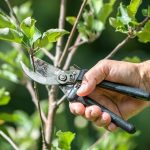
Did you know that the fastest paced tree surgeon course takes over a month to complete? However, by employing some basic principles, it’s possible to cut back trees and shrubs without needing to attend a course that will teach you about not damaging them.
Thank you for reading this post, don't forget to subscribe!
However, if damage is caused, then it can lead to unsatisfactory growth and in some cases, an early demise. Although reading an article such as this won’t deliver the knowledge that you need to be an expert, it can at least impart some vital facts that will enable you to apply some basic principles on what to do.
Timing
It’s a general rule that most plants are sensitive to cold and therefore, should not be pruned until the chance of there being a frost has passed. Pruning causes a wound and they sometimes do not heal well enough to be protected against an infection of bacteria or fungus. Do note that deciduous plants do well to be pruned during their dormant time, ideally at the end of winter. They have evolved for cold-temperature climates and during winter growth will slow down. If they are pruned during spring, they will suffer as that is when the sap can bleed from tissues.
Quantity
No tree or shrub likes to have too much material removed at once. Don’t attempt to take more than one third of the branch volume. We recommend actually going for less than that. Even if the plant is dormant, excessive pruning can have a major effect on the energy level of the plant. If you intend to cut away a lot of material, then go for a staggered approach and do this over a period of 2 years or more.
Quality
As you prune, be aware that every cut is a wound that is a potential source of infection. The woodier plants can protect themselves to some degree and will isolate any rot or decay. However, do keep these points in mind:
- Make a cut as small as possible in comparison to the width of the branch or trunk.
- Do not leave small stubs behind as this is what can suffer from bacterial and fungal attack. This can then go into the main trunk or branches. However, cuts that are made flush with the trunk can callous over and also cause rot.
- Keep pruning saws sharp to keep the cut clean. A jagged cut leaves a greater wound surface area that can be difficult for the tree to isolate as an infection area.
In summary, when and how you prune a tree or a shrub will impact how well it grows. By following these tips, you’re give your garden the best chance of being both healthy and beautiful.
